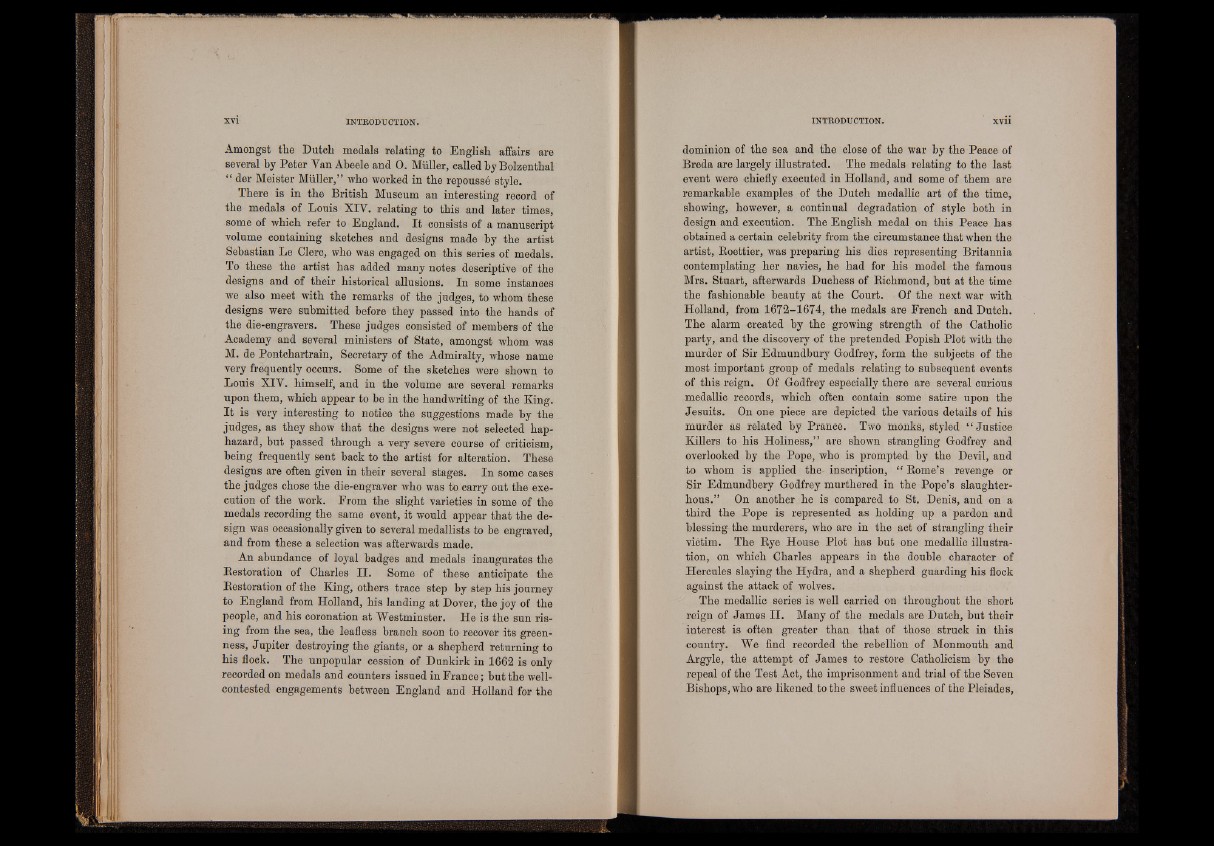
Amongst the Dutch medals relating to English affairs are
several by Peter Yan Abeele and 0. Müller, called by Bolzenthal
“ der Meister Müller,” who worked in the repoussé style.
There is in the British Museum an interesting record of
the medals of Louis XIV. relating to this and later times,
some of which refer to England. I t consists of a manuscript
volume containing sketches and designs made by the artist
Sebastian Le Clerc, who was engaged on this series of medals.
To these the artist has added many notes descriptive of the
designs and of their historical allusions. In some instances
we also meet with the remarks of the judges, to whom these
designs were submitted before they passed into the hands of
the die-engravers. These judges consisted of members of the
Academy and several ministers of State, amongst whom was
M. de Pontchartrain, Secretary of the Admiralty, whose name
very frequently occurs. Some of the sketches were shown to
Louis XIV. himself, and in the volume are several remarks
upon them, which appear to be in the handwriting of the King.
I t is very interesting to notice the suggestions made by the
judges, as they show that the designs were not selected haphazard,
but passed through a very severe course of criticism,
being frequently sent back to the artist for alteration. These
designs are often given in their several stages. In some cases
the judges chose the die-engraver who was to carry out the execution
of the work. Erom the slight varieties in some of the
medals recording the same event, it would appear that the design
was occasionally given to several medallists to be engraved,
and from these a selection was afterwards made.
An abundance of loyal badges and medals inaugurates the
Restoration of Charles II. Some of these anticipate the
Restoration of the King, others trace step by step his journey
to England from Holland, his landing at Dover, the joy of the
people, and his coronation at Westminster. He is the sun rising
from the sea, the leafless branch soon to recover its greenness,
Jupiter destroying the giants, or a shepherd returning to
his flock. The unpopular cession of Dunkirk in 1662 is only
recorded on medals and counters issued in France; but the well-
contested engagements between England and Holland for the
dominion of the sea and the close of the war by the Peace of
Breda are largely illustrated. The medals relating to the last
event were chiefly executed in Holland, and some of them are
remarkable examples of the Dutch medallic art of the time,
showing, however, a continual degradation of style both in
design and execution. The English medal on this Peace has
obtained a certain celebrity from the circumstance that when the
artist, Roettier, was preparing his dies representing Britannia
contemplating her navies, he had for his model the famous
Mrs. Stuart, afterwards Duchess of Richmond, but at the time
the fashionable beauty at the Court. Of the next war with
Holland, from 1672-1674, the medals are French and Dutch.
The alarm created by the growing strength of the Catholic
party, and the discovery of the pretended Popish Plot with the
murder of Sir Edmundbury Godfrey, form the subjects of the
most important group of medals relating to subsequent events
of this reign. Of Godfrey especially there are several curious
medallic records, which often contain some satire upon the
Jesuits. On one piece are depicted the various details of his
murder as related by Prance. Two monks, styled “ Justice
Killers to his Holiness,” are shown strangling Godfrey and
overlooked by the Pope, who is prompted by the Devil, and
to whom is applied the- inscription, “ Rome’s revenge or
Sir Edmundbery Godfrey murthered in the Pope’s slaughter-
hous.” On another he is compared to St. Denis, and on a
third the Pope is represented as holding up a pardon and
blessing the murderers, who are in the act of strangling their
victim. The Rye House Plot has but one medallic illustration,
on which Charles appears in the double character of
Hercules slaying the Hydra, and a shepherd guarding his flock
against the attack of wolves.
The medallic series is well carried on throughout the short
reign of James II. Many of the medals are Dutch, but their
interest is often greater than that of those struck in this
country. We find recorded the rebellion of Monmouth and
Argyle, the attempt of James to restore Catholicism by the
repeal of the Test Act, the imprisonment and trial of the Seven
Bishops, who are likened to the sweet influences of the Pleiades,